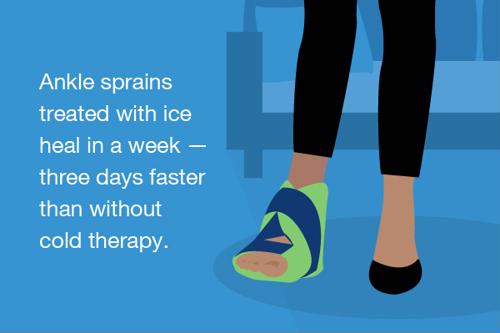
Studies show ankle sprains treated with ice heal three days faster than without cold therapy.
While athletes are quick to submerge their muscles in a bath filled with freezing cold ice water, most of us are inclined to say "no thank you." However, there is a science behind the seemingly crazy concept of an ice-cold bath.
Cryotherapy, more commonly known as cold therapy, is a healing technique that exposes the body to extremely cold temperatures for several minutes. The therapy helps muscles recover after strenuous activity, injury or surgical procedure. By reducing blood flow to a targeted area for a short period of time, the therapy can lessen inflammation, swelling and nerve activity, which in turn relieves pain around muscles, joints and tendons. Fortunately, there are localized cryotherapy methods, which involve ice packs and coolant sprays, rather than the full-body ice bath.
From everyday muscle recovery to targeted pain relief, cold therapy offers many health benefits.
1. Recover from surgery
Many doctors recommend cryotherapy for post-surgical rehabilitation, as it can reduce pain by controlling swelling and inflammation in the affected area. As such, cold therapy can help patients achieve normal function after soft tissue trauma at a much faster rate.
"Cold therapy can help patients achieve normal function after soft tissue trauma at a much faster rate."
2. Soothe injured muscles, joints and tissues
Cold therapy can provide effective relief for minor injuries, such as bruises or sprains, by reducing the inflammation and swelling that causes acute pain. The therapy can even speed up healing time: Ankle sprains treated with ice can heal in about a week, while healing times sans cold therapy can be more than 10 days. Beyond one-time injuries, cryotherapy can treat repetitive strain injuries, including carpal tunnel syndrome, tendonitis, trigger finger, cubital tunnel syndrome, shin splints and plantar fasciitis. It can also provide relief for arthritis patients.
3. Recharge muscles after the gym
Many athletes use cryotherapy for muscle or injury recovery after exercise. The cold treatment helps the muscles repair themselves and prepare for the next training session. In a recent review published in the International Journal of Sports Medicine, the researchers found that cryotherapy helped reduce muscle pain in 80 percent of the observed studies as well as improved athletic recovery and performance in 71 percent of the studies. As such, when incorporated into a regular post-workout routine, cryotherapy can reduce recovery times and improve performance going forward.
4. Find additional pain relief
Cold therapy can also provide relief for headache and migraine pains, as one study found that neck wraps with frozen ice packs numbed nerves and reduced participant symptoms. According to Healthline, cold therapy can also provide relief for dermatitis and other skin conditions, nerve irritations and mood disorders.
If you're ready to cool down your pain levels, check out Polar Ice cold therapy products, designed to provide relief for post-surgical rehabilitation and other injuries or sources of discomfort. Combined with compression, these products go above and beyond homemade ice packs. Plus, they're easily adjustable for universal sizing. Available in jaw, shoulder, hip, wrist, elbow, knee, shin, foot, ankle, back and finger wraps, Polar Ice provides localized cold therapy for various points of pain.
